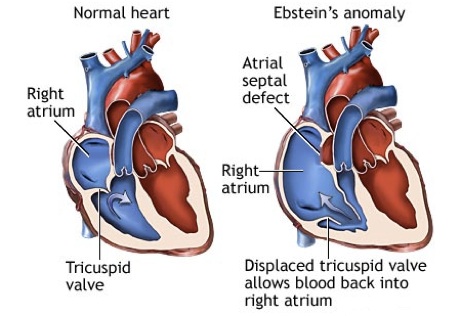resources


resources


Sunday, February 22, 2009
Ebstein's anomaly is a very rare heart defect in which parts of the tricuspid valve are abnormal. The tricuspid valve separates the lower heart chamber (right ventricle) from the upper heart chamber (right atrium).
The condition is congenital, which means it is present from birth.
Causes
The tricuspid valve is normally made of three parts, called leaflets or flaps. The flaps open to allow blood to move from the right atrium (top chamber) to the right ventricle (bottom chamber) while the heart relaxes. They close to prevent blood from moving from the right ventricle to the right atrium while the heart pumps.
In persons with Ebstein's anomaly, one or two of the flaps may stick to the heart wall and cannot move. The flaps are often larger than normal. Sometimes two flaps are in the wrong position in the bottom heart chamber.
The defects can cause blood to leak into the wrong areas of the heart. The backup of blood flow can lead to heart swelling and fluid buildup in the lungs or in the liver. Sometimes, blood can't get out of the heart into the lungs and the person may appear blue.
In some cases, patients also have a hole in the wall separating the heart's two upper chambers. There may be narrowing of the valve that leads to the lungs (pulmonary valve).
Ebstein's anomaly occurs as a baby develops in the womb. The exact cause is unknown, although the use of certain drugs (such as lithium or benzodiazepines) during pregnancy may play a role. The condition is rare. It is more common in white people.
Symptoms
Symptoms range from mild to very severe. Often, symptoms develop soon after birth and include bluish-colored lips and nails due to low blood oxygen levels. In severe cases, the baby appears very sick and has trouble breathing.
Symptoms in older children may include:
•Cough
•Failure to grow
•Fatigue
•Rapid breathing
•Shortness of breath
•Very fast heartbeat
Exams and Tests
Newborns that have a severe leakage will have very low levels of oxygen in their blood and significant heart swelling. The doctor may hear abnormal heart sounds, such as murmur, when listening to the chest with a stethoscope.
Tests that can help diagnose this condition include:
•Chest x-ray
•Magnetic resonance imaging (MRI) of the heart
•Measurement of the electrical activity of the heart (EKG)
•Ultrasound of the heart (echocardiogram)
Treatment
Treatment depends on the severity of the defect and the specific symptoms. Medical care may include:
•Medications to help with breathing problems (digoxin and diuretics) and to prevent infections
•Oxygen and other breathing support
•Surgery to correct the valve or other problems (may be needed for children who continue to get worse or who have more serious complications)
Outlook (Prognosis)
In general, the earlier symptoms develop, the more severe the disease. People with this condition should avoid competitive or strenuous sports.
Some patients may have either no symptoms or very mild symptoms. Others may worsen over time, developing blue coloring (cyanosis), heart failure, heart block, or dangerous heart rhythms.
Possible Complications
A severe leakage can lead to swelling of the heart and liver, as well as congestive heart failure.
Other complications may include:
•Blood clots from the heart to other parts of the body
•Brain abscess
•Complete heart block
•Infection of the sac surrounding the heart (endocarditis)
When to Contact a Medical Professional
Call your health care provider if your child develops symptoms of this condition. Seek immediate medical attention if breathing problems occur.
Prevention
There is no known prevention. However, you may be able to prevent some of the complications of the disease. For example, taking antibiotics before dental surgery may help prevent endocarditis.
Alternative Names
Ebstein's malformation
References
Cyanotic Congenital Heart Defects. In: Park MK, Troxler RG, eds. Pediatric Cardiology for Practioners. 5th ed. St. Louis, Mo: Mosby, Inc; 2008: chap 14.


Ebstein’s Anomaly